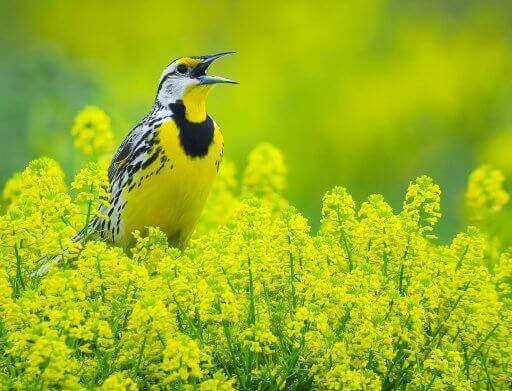Patching the Tattered Fabric, One Farm Bill at a Time
I remember being in the outdoors often with my father when I was a boy. My Dad, Zene, was an avid hunter, angler, and unintentional naturalist, and we were in the fields or at the lake nearly daily. Zene was an Iowa farm boy who grew up to be a career military man. Nature was his respite and great love.
Dad was a wild storyteller and a trickster, always keeping me on my toes, ready to detect malarkey. So, one cloudy pre-dawn when he proclaimed that a distant flock a half-mile away included two drakes and a hen Mallard, I thought it was a joke. To my bewilderment, when the dots turned into ducks that finally swung by our decoys, there were in fact two drakes and a hen Mallard. I was hooked. I wanted to know how Dad knew that, and he began teaching me. With Dad's help and my curiosity, I may now love the wildlife around me as much as he did. I'm especially fond of the wide-open spaces of grasslands and the birds I find there.

We all come to appreciate nature in our own ways. Once we embrace its beauty and significance, many of us realize that modern life and all its machinations have created a wall between humans and the wild, and that many of our activities have taken a toll on nature.
After we connect with the outdoors, as I did through my father and my ramblings, it's easy to see Earth's thin skin as a woven fabric. Looking closer, we can see grasslands and other imperiled ecosystems as frayed patches and declining species as weakened strands. It becomes clear that these things need our care.
You have probably heard that we have lost more than a quarter of the overall population of U.S. and Canadian birds since 1970 — nearly 3 billion birds. The biggest loser: grassland birds, a group with a population that has fallen by 40 percent.

Much of my work focuses on strengthening conservation for these declining grassland birds through the U.S. Farm Bill. It might surprise you to learn that this federal legislation, passed every five years or so, is the largest source of conservation funding in the U.S. We can do a lot for birds by making the Bill stronger for bird conservation, with provisions that encourage bird-friendly conservation while discouraging harmful practices.
I consider the environmentally friendly provisions that may end up in the upcoming Farm Bill as patches that strengthen the biosphere's dwindling strands. A lot of those strands occur on farm and ranch land, which together make up about half of the land area of the contiguous U.S. states. We spend billions of dollars through the Bill each year to help farmers and ranchers conserve their land. These conservation actions can help by providing improved habitat conditions that help birds thrive, while making agriculture more sustainable. Along with what the Farm Bill itself holds in store, the recently enacted Inflation Reduction Act has already provided about $20 billion for Farm Bill conservation programs.
Birds have long benefited from Farm Bill funding. Perhaps you have heard of the Sage Grouse Initiative that has been championed by USDA's Natural Resources Conservation Service. Or maybe you've heard of the State Acres for Wildlife (SAFE) provision within the Farm Service Agency's Conservation Reserve Program. The Farm Bill does a lot for birds already, and with some extra effort, it can do much more.
That's where ABC comes in. For many years, our Policy team has helped to shape the Farm Bill and how it is administered. For the upcoming Bill, which will hopefully pass in 2023, ABC is promoting a “Bird Saver” package of enhanced practices and new policy ideas that boosts bird conservation while helping farmers, ranchers, and rural communities thrive. One example is the Grassland Restoration Incentives Program (GRIP) that was designed and first implemented by ABC and its partners at the Oaks and Prairies Joint Venture in Oklahoma and Texas. GRIP is a partnership-driven program that provides voluntary incentives to landowners to help them restore and manage grasslands for birds and their own livelihoods.
If you want to help, please send a note to your senators and representative supporting the inclusion of our Bird Saver provisions in the next Farm Bill.



















































